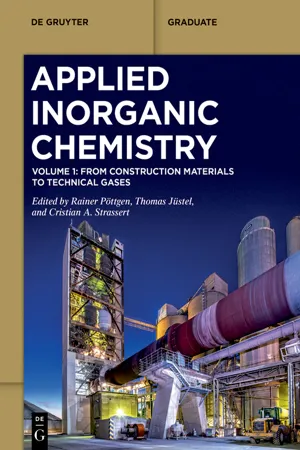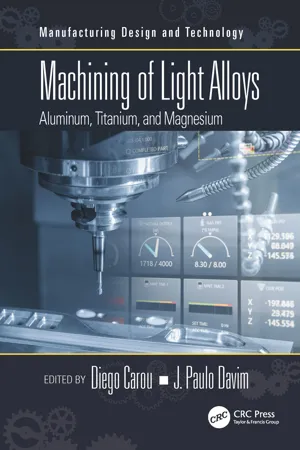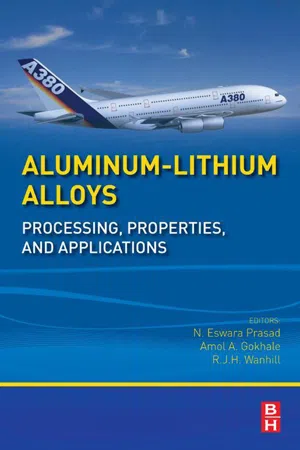Technology & Engineering
Light Alloys
Light alloys are metallic materials with low density, typically composed of aluminum, magnesium, and titanium. They are valued for their high strength-to-weight ratio, making them suitable for applications where weight reduction is critical, such as in aerospace, automotive, and sporting equipment. These alloys offer excellent corrosion resistance and are easily formable, making them versatile in various engineering and manufacturing processes.
Written by Perlego with AI-assistance
Related key terms
Related key terms
1 of 4
Related key terms
1 of 3
4 Key excerpts on "Light Alloys"
- eBook - ePub
- Rainer Pöttgen, Thomas Jüstel, Cristian A. Strassert(Authors)
- 2022(Publication Date)
- De Gruyter(Publisher)
2.3 Metallic light-weight alloys: Al, Ti, Mg
M. BertauMetallic light-weight alloys are usually based on Al, Ti, Mg and Be as main constituents. The applications of the Be-based alloys are addressed separately in Chapter 2.7. Due to their low density and high weight to strength ratio, light-weight alloys are widely used in numerous areas of everyday life. Additionally, all of these are usually non-ferrous alloys with a low toxicity (except for Be), enabling their use in a plethora of applications.2.3.1 Aluminum-based alloys
2.3.1.1 Applications
Aluminum alloys are versatile materials that find application in almost every industrial and commercial sector. Especially the transport sector, e.g. automotive and commercial vehicle construction, rail vehicles (housing, brakes, etc.; Figure 2.3.1 ), as well as aerospace applications rely on these materials [1 , 2 ]. In the automotive industry, the need for weight reduction to achieve CO2 reduction goals along with increasing fuel prices have triggered a serious series of developments of these materials. For decades, the use of aluminum in the automotive industry was limited to molding applications in the drive system. However, the ability to fabricate motor blocks, heat exchangers or parts of the chassis from aluminum alloys have led to significant advances that have also transitioned to the field of commercial vehicles. The transportation sector has realized the advantages of aluminum alloys. Also, the fields of architecture, machine, apparatus and tool construction have employed various available aluminum-based alloys. One of the first attempts to use aluminum in architecture was in the construction of New York’s Empire State building between 1930 and 1931 [3 - eBook - ePub
Machining of Light Alloys
Aluminum, Titanium, and Magnesium
- Diego Carou, J. Paulo Davim(Authors)
- 2018(Publication Date)
- CRC Press(Publisher)
one Light Alloys and their machinability A reviewMohd Danish , Turnad Lenggo Ginta , Muhammad Yasir , and Ahmad Majdi Abdul Rani1.1 Introduction1.2 Properties and applications1.2.1 Aluminum1.2.2 Magnesium1.2.3 Titanium1.3 Machinability of aluminum1.3.1 Cutting temperature1.3.2 Cutting forces1.3.3 Cutting tools1.3.4 Tool wear1.4 Machinability of magnesium1.4.1 Cutting temperature and ignition1.4.2 Cutting speeds1.4.3 Cutting tool1.4.4 Tool wear1.5 Machinability of titanium1.5.1 Cutting temperature1.5.2 Cutting forces1.5.3 Cutting tools1.5.4 Tool wear1.5.5 Chatter1.6 Cryogenic machining of Light Alloys1.7 ConclusionsReferences1.1 IntroductionThe use of Light Alloys or materials having low specific weight is critical in manufactured parts used in aerospace, automobiles, electronics, sports, and biomedical applications. Generally, the term “Light Alloys” is used for alloys having base material aluminum (Al), magnesium (Mg), and titanium (Ti) (Polmear 2005). The density of the part becomes a critical factor when it comes to automobiles and mainly in aerospace. This is due to the fact that weight has a direct relation with the economy of the aerospace and automobile industries. A lighter vehicle will require less power, and a less amount of fuel will be consumed. In case of the space shuttle, mass is more critical as gravitational pull will be more powerful toward the greater mass. Light Alloys have gained the attention of researchers around the globe because of not only their low density but also their other attractive properties, like the good machinability of magnesium, electrical and thermal conductivity of aluminum, and high corrosion resistance of titanium.Machining is widely used for manufacturing products used in various industries like aviation, automobiles, and biomedical. There is not a fixed definition of machinability of materials, but still, it can be defined as ease of the material to be machined to have the required shape and size. It can also be defined from the power consumption perspective and the morphology of the chips (Elgallad et al. 2010). However, machining is not easy when it comes to Light Alloys. This chapter will review the properties and the machinability of Light Alloys focusing mainly on aluminum-, magnesium-, and titanium-based alloys. A special section for cryogenic machining of Light Alloys is also presented in this chapter. - P.K. Mallick(Author)
- 2010(Publication Date)
- Woodhead Publishing(Publisher)
Part II Manufacturing and design of lightweight automotive structuresPassage contains an image 7
Manufacturing processes for Light Alloys
G.T. Kridli, University of Michigan–Dearborn, USAP.A. Friedman and J.M. Boileau, Ford Research and Innovation Center, USAAbstract:
This chapter highlights the manufacturing processes used to fabricate lightweight automotive parts. The chapter provides an overview of aluminum and magnesium alloys; describes design issues and manufacturing challenges for Light Alloys; highlights commonly used metal casting and metal forming processes; identifies enablers to significantly increase the use of Light Alloys in the production of automotive parts; and describes some of the promising metal forming technologies for Light Alloys.Key words metal forming processes metal casting processes7.1 Choosing Light Alloys
In the past three decades, weight reduction in automotive components has become a key focus area. This has been due to the need to meet increased customer expectations of vehicle safety, performance, and reduced emissions while complying with regulations on fuel economy. one important method of weight reduction involves redesigning existing components to use lightweight materials for vehicle body construction.The key to the effective use of these lightweight materials is to tailor the material and the processes to the parts of the vehicle structure. Typically, sheet is used to create two- and (simpler) three-dimensional shapes such as hoods, decklids, and body panels. More complex three-dimensional forms with reinforcing webs are more commonly created from castings. In the selection of the fabrication method, cost and functionality must be analyzed to create both an efficient and cost-effective solution. Under certain conditions, an assembly created from multiple stamped parts welded together will be the most effective; under other conditions, a single large-scale casting that integrates multiple features may be optimum.- eBook - ePub
Aluminum-Lithium Alloys
Processing, Properties, and Applications
- N Eswara Prasad, Amol Gokhale, R.J.H Wanhill(Authors)
- 2013(Publication Date)
- Butterworth-Heinemann(Publisher)
Development of the 2nd generation alloys began in the 1970s and continued through the 1980s. Attempts were made to develop families of Al-Li alloys for widespread replacement of conventional alloys. Ultimately this was unsuccessful except for ‘niche’ applications. The failure to find widespread application was associated largely with the too-high lithium contents of the alloys (typically more than 2 wt%). This resulted in serious disadvantages, including mechanical property anisotropy, low short-transverse ductility and fracture toughness, and thermal instability.Development of the 3rd generation Al-Li alloys began in the late 1980s and is ongoing. These alloys have significantly reduced lithium contents (0.75 – 1.8 wt%) and there are other important compositional changes. Silver and zinc have been added for strength, and zinc improves the corrosion resistance; and manganese is added besides zirconium, which was already present in 2nd generation alloys, to control recrystallization and texture. These differences and improved knowledge about thermomechanical processing and heat-treatment have resulted in a family of alloys with significant property advantages covering all major structural areas and applications for transport aircraft.ContentsKeywords
Al-Li alloys; aerostructures; engineering properties2.1 Introduction 2.2 Aircraft Structural Property Requirements 2.2.1 Fuselage/Pressure Cabins 2.2.2 Wings 2.2.3 Empennage (Tail) 2.3 Engineering Property Requirements for Al–Li Alloys in Aircraft Structures 2.3.1 The Key Role of Lithium Content: Density and Stiffness 2.3.2 Strength and Ductility 2.3.3 Damage Tolerance 2.4 Families of Al–Li Alloys 2.4.1 Second-Generation Alloys 2.4.2 Third-Generation Alloys 2.5 Examples of Third-Generation Alloy Property Developments and Trade-Offs 2.5.1 Fuselage/Pressure Cabins 2.5.2 Upper Wings 2.5.3 Lower Wings 2.5.4 Spars, Ribs, and Other Internal Structures 2.6 Service Qualification Programs 2.7 Summary and Conclusions References2.1 Introduction
Aircraft structural alloys must have outstanding combinations of engineering properties and also enable lightweight and durable structures to be manufactured. Aluminum alloys have been the predominant materials of choice since the introduction of the Boeing 247 (1933) and Douglas DC-2 (1934), although composites (mainly carbon fiber) and titanium alloys nowadays provide competition for certain applications. There is a notable trend toward using composites extensively in the airframes of transport (passenger and cargo) aircraft (e.g. the Boeing 787 Dreamliner
Index pages curate the most relevant extracts from our library of academic textbooks. They’ve been created using an in-house natural language model (NLM), each adding context and meaning to key research topics.
Explore more topic indexes
Explore more topic indexes
1 of 6
Explore more topic indexes
1 of 4



